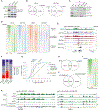The SS18-SSX Fusion Oncoprotein Hijacks BAF Complex Targeting and Function to Drive Synovial Sarcoma
- PMID: 29861296
- PMCID: PMC6791822
- DOI: 10.1016/j.ccell.2018.05.002
The SS18-SSX Fusion Oncoprotein Hijacks BAF Complex Targeting and Function to Drive Synovial Sarcoma
Abstract
Synovial sarcoma (SS) is defined by the hallmark SS18-SSX fusion oncoprotein, which renders BAF complexes aberrant in two manners: gain of SSX to the SS18 subunit and concomitant loss of BAF47 subunit assembly. Here we demonstrate that SS18-SSX globally hijacks BAF complexes on chromatin to activate an SS transcriptional signature that we define using primary tumors and cell lines. Specifically, SS18-SSX retargets BAF complexes from enhancers to broad polycomb domains to oppose PRC2-mediated repression and activate bivalent genes. Upon suppression of SS18-SSX, reassembly of BAF47 restores enhancer activation, but is not required for proliferative arrest. These results establish a global hijacking mechanism for SS18-SSX on chromatin, and define the distinct contributions of two concurrent BAF complex perturbations.
Keywords: ATP-dependent chromatin remodeling; SWI/SNF (BAF) complexes; bivalency; chromatin; enhancers; fusion oncoprotein; pediatric cancer; polycomb; synovial sarcoma.
Copyright © 2018. Published by Elsevier Inc.
Figures






Comment in
-
Epigenetic ConFUSION: SS18-SSX Fusion Rewires BAF Complex to Activate Bivalent Genes in Synovial Sarcoma.Cancer Cell. 2018 Jun 11;33(6):951-953. doi: 10.1016/j.ccell.2018.05.011. Cancer Cell. 2018. PMID: 29894696
References
-
- Arnold MA, Arnold CA, Li G, Chae U, El-Etriby R, Lee CC, and Tsokos M (2013). A unique pattern of INI1 immunohistochemistry distinguishes synovial sarcoma from its histologic mimics. Hum. Pathol 44, 881–887. - PubMed
-
- Bernstein BE, Mikkelsen TS, Xie X, Kamal M, Huebert DJ, Cuff J, Fry B, Meissner A, Wernig M, Plath K, et al. (2006). A bivalent chromatin structure marks key developmental genes in embryonic stem cells. Cell 125, 315–326. - PubMed
Publication types
MeSH terms
Substances
Grants and funding
LinkOut - more resources
Full Text Sources
Other Literature Sources
Molecular Biology Databases

